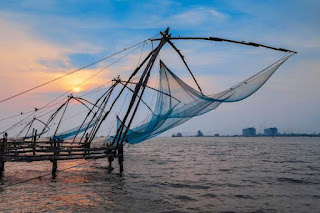Queen of Arabian Sea

HISTORY
Kochi merchants began trading in spices such as black pepper and
cardamom with the Arabs, Dutch, Phoenicians, Portuguese, and Chinese
more than 600 years ago. This helped Kochi to prosper and to become the gateway
to old India. It was from Kochi that the colonization of India started.
Portugal was first to establish its base in Kochi in the 1500s, followed by the
Dutch and English.
The British managed to establish their influence over Kochi, limiting
their direct administration to a small enclave of Fort Kochi and British
Ernakulam with their capital at Bolgatty Island. The rest of the Kochi was
administered by Kochi Maharajas from their capital at Thripunithura.
 |
| Bolgatty Island |
The foundations of modern Kochi city started when Sir Robert Bristow, a senior Royal Navy Engineer felt the need for a modern large port after the opening of the Suez Canal. This made the creation of the largest man-made island in the country, the Willingdon Island to house the new Kochi Port.
 |
In the 1930s, the Kochi Maharaja joined the public outcry
to form a common state of Malayalam-speaking people by merging with the Kingdom
of Travancore and British Malabar. In 1947, the Kingdom of Kochi and Travancore
merged to form the Royal State of Travancore-Kochi. The Kochi Maharaja was
amongst the first to advocate the state joining the newly formed Indian Union.
Finally, in 1949 the state of Travancore-Kochi merged with India.
Since the formation of Kerala in 1957, Kochi has been the commercial capital of Kerala as well as the seat of the Kerala High Court. Since 2000, Kochi has revitalized its economy, with a focus on tourism, information technology, and the port.
Kochi has a cosmopolitan culture, highly influenced by historical trading partners. Kochi has an unusual higher Christian population, thus the city being the seat of the Latin church of India, the ecclesiastical seat of one of the 4 Catholic Cardinals of India and has many Catholic churches and followers apart from other religious orders of Christianity.
Kochi was traditionally a potpourri
of various Indian and international communities. Syrian Christians started the
first wave of immigration, followed by Jews between the 7th and 10th centuries.
Arab merchants also made a strong settlement in Kochi. In the 15th century,
Gujaratis settled in Kochi, especially on Mattencherry Island, where they
played a strong role in spice trading and other areas.
Later, at the beginning of the
colonial era, the Portuguese, Dutch, French, and British all made their
settlements in Kochi. The Portuguese had a strong influence in Fort Cochin
while Dutch has lent many of its words and culinary influence into local
cultures. British culture was strongly felt, lending Kochi a strong community
of Anglo-Indians, the largest of the social group in India.
In the early 1970s, Punjabis settled
here, focusing their strong presence on the local automobile industry.
Tamilians, Telugus, Kannadigas have all formed small settlements since the days
of royalty. Recently, students from Cambodia, Thailand, Korea, and Indonesia
have settled down in Kochi for studies and research activities. Kochi has a
sizeable expatriate population mainly from European countries who have settled
in Fort Kochi. Most of them are senior citizens who settled down to enjoy
retirement life and many run boutique hotels and restaurants in that area. Due
to the rapid growth of the city, a majority of the local population are
immigrants.
TOURIST HUB
 |
| Vasco da Gama Square |









Comments
Post a Comment